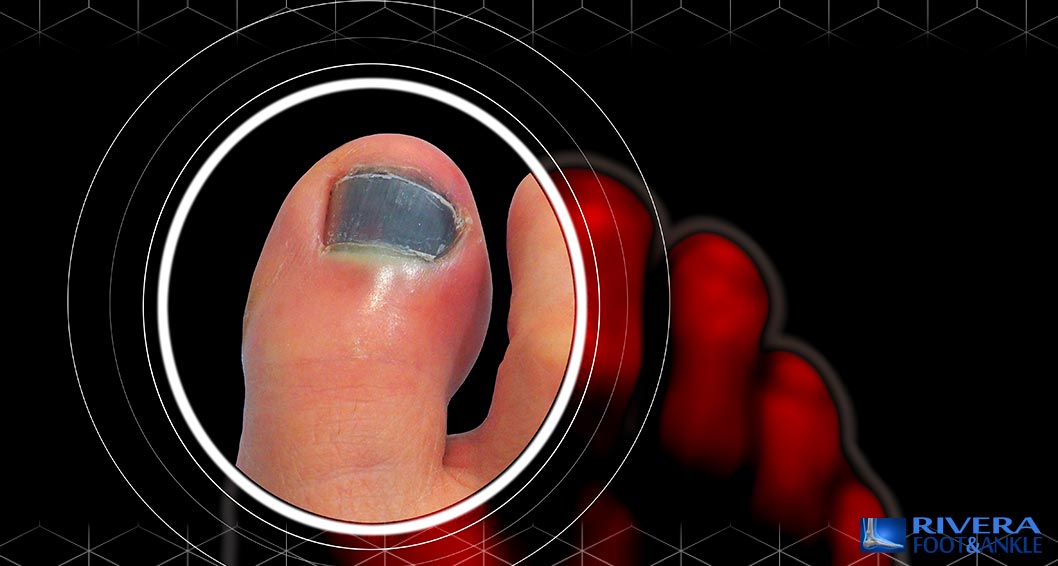
Treatment of Foot and Ankle
Subungual Hematoma: Treating Runner’s Toe
Many runners, at some point during their running career, will experience a black toenail (aka a subungual hematoma or runner’s toe). During my last half marathon, I actually developed two! Although the nail changes may not always cause pain, they should not be ignored.
Learn more about what causes black toenails, the different treatment options, and why it is important to monitor them until they fully heal.
Causes
A subungual hematoma is an accumulation of blood underneath the nail plate. This usually results from one of two mechanisms: either something drops on the toenail, or, in the case of runners, repeated trauma of the toenail against the shoe causes injury to the surrounding blood vessels, resulting in the accumulation of blood underneath the nail.
Treatment Options
1. Leave alone
If the nail is intact and the toe is not painful, no treatment may be required. The discoloration may take several months to resolve, so it is important to monitor it and make sure that the blackish color eventually goes away. It is also good to watch for any signs of infection (e.g. increased redness, swelling, pain, purulent drainage) and notify your doctor should any arise. If the blackish discoloration is not the result of trauma, you also should not wait to seek medical advice. A healthcare professional should evaluate it and do further work-up to determine its diagnosis and cause.
2. Puncture the nail
The accumulation of blood underneath the nail plate can cause added pressure and pain. In this case, the nail can be punctured and the blood drained. This will relieve the pressure, thus relieving the pain. The procedure should be performed by a healthcare professional, who can trephine the nail plate using sterile instrumentation and ensure that the instrument is not penetrating too deep and injuring the nail bed. After the procedure, the area needs to be cleaned and protected until it heals. If the blood builds up again, or the nail plate is loose, removal of the entire nail should be considered.
3. Removal of the nail plate
Instead of just puncturing the nail, the entire nail can be removed, which has its advantages. First, it allows for better visualization of the nail bed underneath to examine for further digital damage. Second, the toe can be better cleaned, which will help minimize the risk of infection. Lastly, there is no chance of recurrence of the subungual hematoma because there is no nail left. The main disadvantage of not having a nail plate is the loss of added protection over the toe while waiting for the new nail to grow out, which may take 6 months to 1 year (toenails grow at an average rate of 1mm/month).
Other things to consider
As a physician, there are two very important things to keep in mind when someone comes into the clinic with black toenails. The first is determining the extent of the injury. There are some cases in which there is not only an accumulation of blood underneath the nail plate, but the toe itself is injured and possibly fractured. If this is in question, radiographs should be taken to evaluate for any broken bones and then treatment should be altered accordingly. Secondly, it is important to obtain a thorough history from the patient with regards to how the toenail turned black. If there was no history of trauma, there is extension of blackness onto the skin, and/or the blackness has spread or not gone away, a melanoma (a type of skin cancer) should be considered and a skin biopsy may need to be performed.
Fuente: ayfpodiatry
RIVERA FOOT & ANKLE: At Orlando H.Rivera DPM, our priority is to deliver quality care to informed patients in a comfortable and convenient setting. When you have problems with your feet, you need to turn to a podiatrist who listens and responds… an experienced doctor who knows the field and can effectively diagnose and treat your needs… a friendly physician who counsels you on the best ways to maintain and improve your health. Our physician(s) meet all these criteria. Plus, you benefit from a dedicated team of trained professionals who give you the individualized attention you deserve.

Treatment of Foot and Ankle
Foot and Ankle, Dr. Orlando Rivera, Advanced Foot & Ankle Specialist, Foot and Ankle Podiatry, Houston Foot & Ankle Surgical, Treatment of Foot and Ankle, Foot & ankle specialists, Podiatrist in houston, podiatrist in houston, Orlando H.Rivera DPM, Houston Foot Doctor, Foot and Ankle Surgeon Houston, Ankle and Foot Specialist Houston, Podiatrist Houston, Foot Pain Houston.



